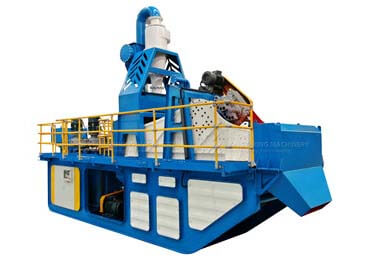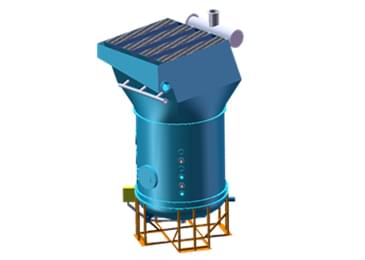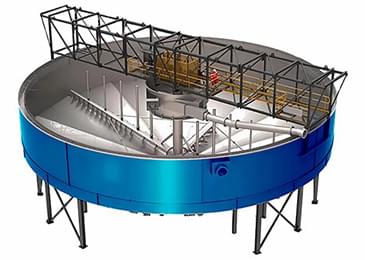What are the methods for sludge dewatering
2021-10-16
There are many methods for sludge dewatering. What are the specific methods? Many customers still don’t understand. This article will give you a detailed introduction to several methods of sludge dewatering.
A sludge treatment method that removes water from fluid native, concentrated, or digested sludge and converts it into semi-solid or solid sludge. After dewatering, the moisture content of the sludge can be reduced to 55 to 80%, depending on the nature of the sludge and sediment and the effectiveness of the dewatering equipment. The further dehydration of sludge is called sludge drying, and the moisture content of the dried sludge is less than 10%. The methods of dehydration mainly include the natural drying method, mechanical dehydration method, and granulation method. The natural drying method and mechanical dehydration method are suitable for sewage sludge. The granulation method is suitable for the coagulation and sedimentation of sludge.
1. Natural drying method
The main structure is a sludge drying field, a flat ground surrounded and separated by an earth embankment. If the soil has poor water permeability, a thin layer of gravel and sand can be laid, and a drainage concealed pipe can be installed. Rely on infiltration and evaporation to reduce the water content of the sludge discharged onto the field. The infiltration process is completed in about 2 to 3 days, and the moisture content can be reduced to about 85 percent. After that, it mainly relies on evaporation, which can be reduced to about 75% after a few weeks. The dewatering effect of the sludge drying field is affected by the local rainfall, evaporation, temperature, humidity, etc. Generally suitable for use in dry, low rainfall, sandy soil areas.
2. Granulation dehydration method
The water granulation dehydrator is a new type of equipment developed. The main body is a horizontal cylinder made of steel plate, which is divided into a granulation part, a dehydration part, and a compaction part, and it rotates slowly around a horizontal axis. The sludge after adding the polymer coagulant first enters the granulation part. Under the action of the sludge’s own gravity, it flocculates and compresses, and rolls into mud pellets in layers. Then the mud pellets and water enter the dewatering part, and the water is discharged from the ring. Discharge from diagonal slits. Finally, it enters the compaction part, and the mud pellets are further compressed and dehydrated under their own weight to form large and dense mud pellets, which are pushed out of the cylinder. The granulator has a simple structure, is not easy to wear, has low power consumption, and is easy to maintain. The moisture content of the mud pill is generally about 70%.
The filtrate produced in the process of sludge dewatering in the sewage treatment plant contains high concentrations of pollutants except for the less pollutant content of the filtrate in the drying bed. Therefore, this filtrate must be treated, usually together with the inflowing wastewater.
3. Mechanical dehydration method
Generally, the sludge is pretreated first to improve the dewatering performance and then dewatered. The most common pretreatment method is to add inorganic salt or polymer coagulant. In addition, there are elutriation and heat treatment methods. Mechanical dehydration methods include filtration and centrifugation. Filtration is to filter the wet sludge with a filter layer (porous material such as filter cloth, metal wire mesh) so that the water (filtrate) permeates the filter layer, and the dehydrated sludge (filter cake) is trapped on the filter layer. The centrifugal method uses the different centrifugal tendencies produced by the difference in the specific gravity of solid and liquid in the sludge to achieve mud-water separation.
The equipment used in the filtration method includes a vacuum filter, a plate and frame filter press, and a belt filter.
The vacuum filter continuously feeds and discharges the mud, and it runs smoothly, but there are many auxiliary facilities.
The plate and frame filter press is a commonly used equipment in the chemical industry. It has a large filtration driving force, a low moisture content of the mud cake, and an intermittent mud inlet and outlet, resulting in low productivity. Manually operated plate and frame filter presses are very labor-intensive, and most of them are automatically operated by machinery.
The belt filter is a new type of filter with a variety of designs and different dehydration principles (gravity filtration, pressure filtration, capillary water absorption, granulation), but they all have a rotary belt, which transports mud and dehydrates at the same time, or Only the role of mud transport. They are similar in complexity and energy consumption.
The centrifugal method is commonly used in horizontal high-speed sedimentation centrifugal dehydrator, which is composed of inner and outer drums. One end of the drum is cylindrical and the other end is conical. The speed is generally around 3000 rpm or higher, and there is a certain speed difference between the inner and outer drums. The centrifugal dewatering machine is continuously produced and automatically controlled and has good sanitary conditions and a small area, but the requirements for sludge pretreatment are higher.
The mechanical dewatering method is mainly used for primary sedimentation tank sludge and digested sludge. The moisture content of dewatered sludge is related to the nature of the sludge and the dewatering method. Under normal circumstances, the moisture content of the mud cake by vacuum filtration is 60% to 80%, the water content of plate and frame filter is 45% to 80%, and the water content of centrifugal dehydration is 80%. To eighty-five percent.









